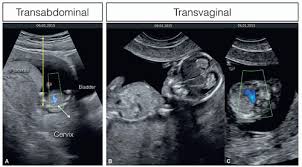Ultrasound has revolutionized modern medical diagnostics, offering a non-invasive and highly effective way to visualize internal organs. Among the most commonly used ultrasound techniques in gynecology and obstetrics are transabdominal and transvaginal ultrasounds. Understanding their differences is essential for both patients and healthcare providers, ensuring the most appropriate imaging technique is selected based on individual needs.
Understanding Ultrasound Technology
Ultrasound imaging operates on high-frequency sound waves that bounce off internal structures to create real-time images. Unlike X-rays, ultrasound does not use ionizing radiation, making it exceptionally safe. The technology provides critical insights into organ function, fetal development and various gynecological conditions.
What is Transvaginal Ultrasound?
A transabdominal ultrasound involves placing a handheld probe (transducer) on the abdomen, usually over a gel-coated surface. The sound waves penetrate the abdominal wall and create images of pelvic structures. It is widely used in obstetrics and general gynecological examinations.
What is Transvaginal Ultrasound?
Unlike transabdominal ultrasound, a transvaginal ultrasound requires the insertion of a slender probe into the vagina. This method allows for a closer and more detailed visualization of the uterus, ovaries and surrounding tissues, offering superior resolution in certain diagnostic scenarios.
Key Differences Between Transabdominal and Transvaginal Ultrasound
- Approach: Transabdominal involves external scanning, while transvaginal is an internal procedure.
- Image clarity: Transvaginal ultrasound provides higher resolution images due to its proximity to pelvic structures.
- Patient comfort: Some patients find transvaginal ultrasound slightly uncomfortable, but it is generally well-tolerated.
When is Transabdominal Ultrasound Recommended?
Transabdominal ultrasound is commonly used for:
- Routine pregnancy check-ups
- Detecting large fibroids or ovarian cysts
- Initial assessment of pelvic pain or unexplained bleeding
When is Transvaginal Ultrasound Recommended?
This method is preferred in cases where greater image detail is needed, such as:
- Early pregnancy confirmation and ectopic pregnancy detection
- Monitoring follicular development in fertility treatments
- Diagnosing endometriosis or polyps
Comparing Image Quality and Diagnostic Accuracy
Since transvaginal ultrasound places the probe closer to internal organs, it offers sharper more detailed images, particularly for small abnormalities. Transabdominal ultrasound, while providing a broader field of view, may lack precision for detecting minute structural changes.
Comfort and Patient Experience
While transabdominal ultrasound is entirely external, requiring only a full bladder for better imaging, transvaginal ultrasound involves internal insertion, which some patients may find slightly invasive. However, it is generally painless and conducted with the utmost care for patient comfort.
Safety and Potential Risks
Both methods are safe and non-invasive. Transvaginal ultrasound may cause mild discomfort but poses no risk to fertility or pregnancy. Healthcare professionals ensure a sterile, careful approach to maximize patient well-being.
The Role of Ultrasound in Pregnancy
Ultrasound plays a crucial role in fetal monitoring, from confirming pregnancy to tracking growth and detecting anomalies. While transabdominal ultrasound is standard in later trimesters, transvaginal ultrasound is more effective in early pregnancy assessments.
Ultrasound in Diagnosing Gynecological Conditions
These imaging techniques help detect conditions like:
- PCOS: Identifying multiple ovarian cysts
- Fibroids and cysts: Evaluating size and impact on fertility
- Endometriosis: Assessing tissue abnormalities
Advances in Ultrasound Technology
Modern innovations have enhanced ultrasound capabilities, including:
- 3D and 4D imaging: Offering detailed fetal images
- Doppler ultrasound: Measuring blood flow abnormalities
- AI-enhanced imaging: Improving diagnostic precision
Choosing the Right Ultrasound Based on Medical Needs
Doctors decide on the ultrasound type based on symptoms, medical history and diagnostic requirements. In some cases, both transabdominal and transvaginal ultrasounds are used together for a comprehensive assessment.
Conclusion
Understanding the differences between transabdominal and transvaginal ultrasound empowers patients to make informed decisions regarding their reproductive health. Consulting with a healthcare provider ensures the most suitable diagnostic approach for each individual case.


No Comments